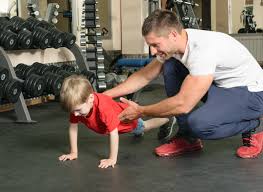Safe and Effective Participation of Youth athlete in Resistance Training
Today people of all ages are aware of health and fitness. Children and adolescents are active in different fitness and sporting activities that require healthy muscle strength, agility, and balance in their school based sporting activities. So, there is a significant increase in the participation of young athletes in resistance training programs. In the past, many studies have raised concerns about the safety and potential injuries to a developing musculoskeletal system of youth athletes participating in weight training. However, today we have growing number of standard studies showing the safe and effective practice of well designed and supervised resistance training program for overall growth and development of children and adolescents.
Risk factors and injuries
But there are always a number of risk factors that can compromise safety and efficacy of resistance training regardless of age or sex of an athlete. Appropriate preventive measures are important along with age appropriate training recommendations. The potential of soft tissue injuries and growth plate injuries are two major concerns associated with youth strength training.
Soft tissue injuries due to overtraining, poor exercise technique, poor exercise design in terms of exercise intensity, duration, or volume of resistance training is inevitable regardless of age factor of an athlete. Thus, the risk of soft tissue injuries among youth athletes with resistance training can easily be addressed with appropriate training technique under professional supervision.
The injury to growth cartilage can result in severe pain, disturbance in child growth, impaired stability and balance, and in chronic cases can result in disability. However, the good news is, no studies on resistance training among youth athletes that were carried under professional guidance and supervision has reported any risk of growth plate injury with resistance training. Instead, many studies have reported a significant gain in muscle strength and performance among youth with weight training without any report of injury.
Prevention
 Thus, in the nutshell, if we address few risk factors of injury associated with resistance training, youth athletes can benefit safely from strength training in terms of overall physical fitness, strength, and performance. Further large-scale randomized trials are warranted to provide strong measures to prevent resistance training injury in youth. Few preventive measures like proper comfortable sports gears, adequate dynamic warm up and cool down periods, well-designed exercises for the whole body, proper exercise technique, body positioning, stabilization, rest periods, stretchings and professional supervision and instructions could be very beneficial for safe and effective resistance training among youths.
Thus, in the nutshell, if we address few risk factors of injury associated with resistance training, youth athletes can benefit safely from strength training in terms of overall physical fitness, strength, and performance. Further large-scale randomized trials are warranted to provide strong measures to prevent resistance training injury in youth. Few preventive measures like proper comfortable sports gears, adequate dynamic warm up and cool down periods, well-designed exercises for the whole body, proper exercise technique, body positioning, stabilization, rest periods, stretchings and professional supervision and instructions could be very beneficial for safe and effective resistance training among youths.
References
Behm DG, Faigenbaum AD, Falk B, et al. Canadian Society for Exercise Physiology position paper: resistance training in children and adolescents. Appl Physiol Nutr Metab 2008;33:547–61
British Association of Exercise and Sports Sciences. BASES position statement on guidelines for resistance exercise in young people. J Sports Sci 2004;22:383–90.
Faigenbaum A, Milliken L, Moulton L, et al. Early muscular fitness adaptations in children in response to two different resistance training regimens. Pediatr Exerc Sci 2005;17:237–48.
Falk B, Mor G. The effects of resistance and martial arts training in 6- to 8-year old boys. Pediatr Exerc Sci 1996;8:48–56.
Falk B, Eliakim A. Resistance training, skeletal muscle, and growth. Pediatr Endocrinol Rev 2003;1:120–7.
Malina R. Weight training in youth – growth, maturation, and safety: an evidenced-based review. Clin J Sports Med 2006;16:478–87.
Micheli L, Nielson J. Overuse injuries in the young athlete: stress fractures. In: Hebestreit H, Bar-Or O, eds. The young athlete. Malden, MA: Blackwell Publishing, 2008:151–63.
Myer G, Wall E. Resistance training in the young athlete. Oper Tech Sports Med
2006;14:218–30
Risser WL, Risser JM, Preston D. Weight-training injuries in adolescents. Am J Dis Child 1990;144:1015–17.

